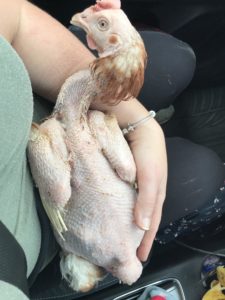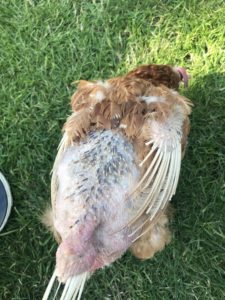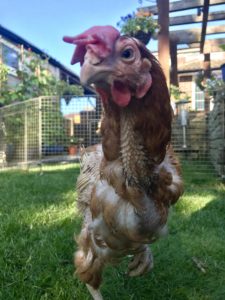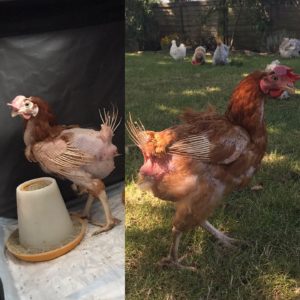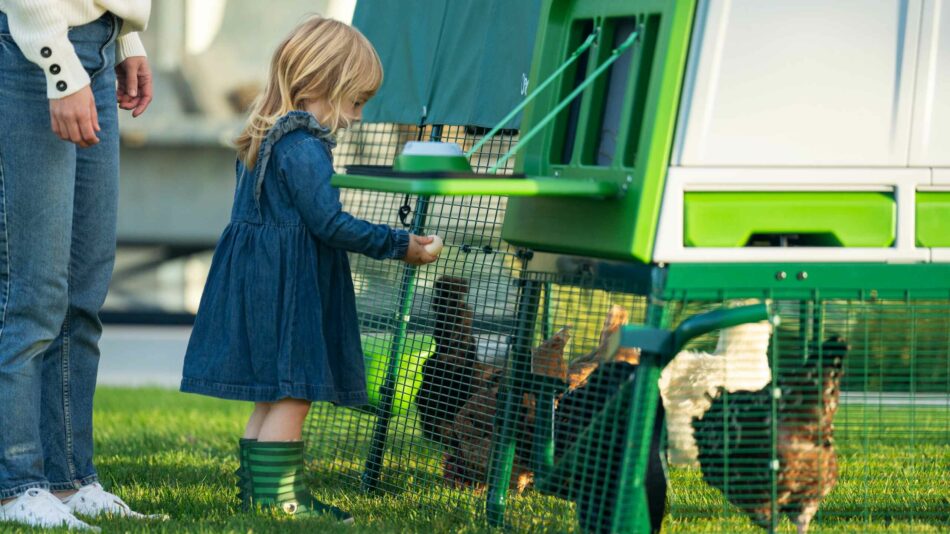
So, you’ve decided keeping chickens is a good fit for your lifestyle, but have you decided on what kind of chickens to keep? Chickens come in a variety of sizes and colours, with different breeds offering unique traits. Dive into the world of chickens, and discover how to choose the right chickens for you.
Which chickens are best for me?
Different breeds of chickens offer different advantages, so choosing the right chickens for you depends largely on your family and lifestyle, along with your climate and amount of space available. There’s not a one-size-fits-all option, but many types of chickens can be kept by anyone just about anywhere. And, no matter which type of chickens you choose, remember that all flocks need a weather-proof chicken coop and a space to call their own – whether it be in a chicken run, chicken fencing, or safe area to free-range.
Best breeds for children
Some breeds of chickens are known for their sweet and docile dispositions, which make them a favourite among children. Each chicken’s personality isn’t guaranteed no matter their breed, but some are known to be easier to tame and handle than others. Here are the most common chicken breeds for children:
Best breeds for small spaces
Size may be of concern for some people, but some chickens are found in miniature form. The breeds listed are “true bantams”, meaning they don’t have a full-size counterpart, but some full-size breeds have bantam versions. These compact breeds are perfect for smaller spaces, but still have big personalities to share with their keepers:
Best breeds for free-ranging
Some chickens are more voracious foragers than others. These breeds can do well in a large chicken run, but they need plenty of space to satisfy their wanderlust. They’re also large and nimble enough to evade several chicken predators, making these a good choice for open spaces:
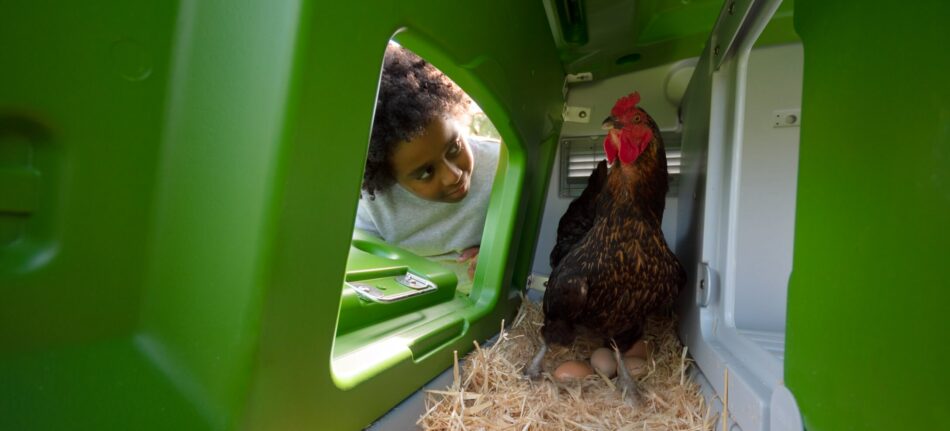
Best breeds for egg production
Good egg laying breeds can produce upwards of 250 eggs per year. These breeds are known to produce eggs year round, and well into their older years. If you’re looking to supply your family with fresh eggs, look no further than these egg-laying superstars:
Best breeds for egg colour
All hens lay eggs, but some can diversify your egg basket in beautiful ways. White and brown eggs are still beautiful, but if you’re looking for pops of colour, you may be interested in adding a breed that lays pigmented eggs. From blue and green, to shades of cream and pink, here are the breeds that lay colourful eggs.
Blue eggs:
Green eggs:
- Easter Egger
- Favaucana
- Swedish Isbar
- Olive Egger (Maran/Ameraucana crosses)
- Whiting True Green
Cream or pink eggs
Brown eggs:
White eggs:
Best breeds for warm climates
Not all chickens can withstand the heat. In fact, most breeds fare better in the cold than in the heat, but some have natural traits that help them cope with scorching summers better than others. Large combs and light body weights are characteristics that help hens in the hot weather, which are standard features in these breeds:
Best breeds for cold climates
Most chickens fare just fine in the cold, but just as some breeds are better equipped to handle the heat, some are more cold-hardy. Small combs aren’t as subject to frostbite, heavier builds add insulation, and feathered legs offer extra protection from the cold air. These are some breeds that are built for the cold:
Chickens that require a little extra care
Generally speaking, chickens are easy to take care of. They won’t overeat, so their feed can be left out at all times, and as long as they have access to fresh water, they’ll slake their thirst when the need arises. But some breeds may require a little extra attention than others.
Ornamental chickens have feathers that can get muddy or caked in debris. These breeds include:
The feathering of these breeds can also make them more susceptible to extreme temperatures, which is especially true for Frizzles and Silkies. This is because their fluffy feathers don’t help them regulate their body temperature as well as their sleek-feathered friends. If you live in a climate that experiences extreme temperatures, or if your property has a tendency to get extremely muddy, you might want to consider other breeds.
Omlet and your chickens
No matter which chickens you choose, they’ll be fortunate to have an owner that puts in the research to give them the best possible home. By housing your hens in safe chicken coops, spacious chicken runs, and providing them with one-of-a-kind chicken toys and accessories, you’ll be your flock’s favourite person. By providing for their basic needs, and then some, you’ll build a bond with your birds that will span a lifetime.
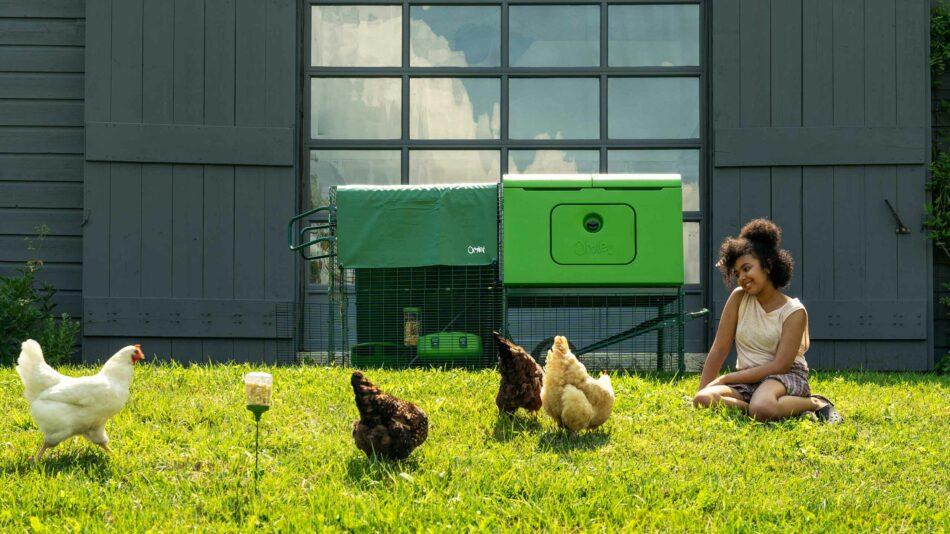

This entry was posted in Chickens on August 27th, 2019 by linnearask
Ever heard the expression ‘cooped up’? It means being stuck indoors with nothing to do, resulting in frustration and boredom. We tend to lock hens in a chicken coop, and that’s where the saying comes from.
A hen kept in a shed with nothing to do will soon start to show all the signs of boredom, just like a human. She may start pecking at her neighbours, or plucking out her own feathers. If blood is drawn, the other hens will often join in the beak-attack, and hens can actually be killed in a frustrated frenzy of pecking.
With nothing better to peck and scratch at, chickens may also start to eat their own and other hens’ eggs. Once a chicken becomes an egg-eater, it’s very hard to make her kick the habit.
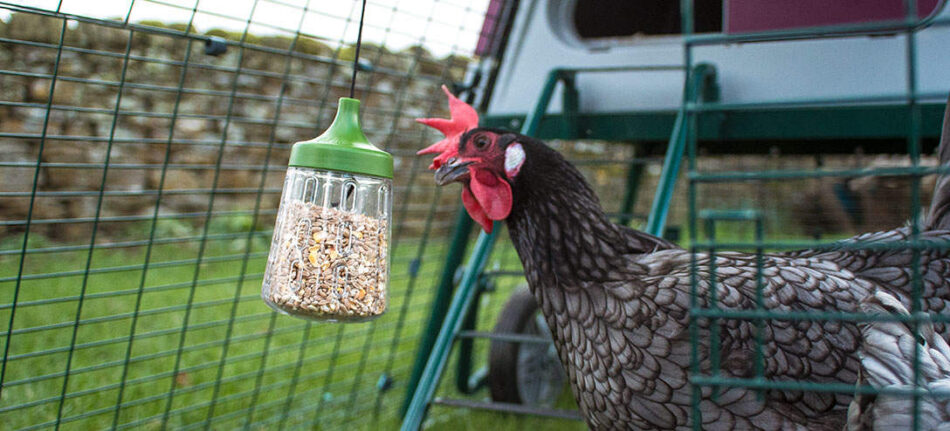
Bored birds will also tend to sit in the egg box all day, and may become weak through lack of exercise. Boredom also causes stress, and stress can bring egg production to a temporary halt.
Bidding Bye-Bye to Bantam Boredom
As usual, prevention is the best cure, and there are many ways of stopping boredom from becoming a problem in the chicken run. The general rule is simple enough – don’t keep hens cooped up!
- Room to Roam – Give your chickens as much outdoor space as possible. If they have a garden or meadow to peck and scratch in, that’s ideal. You don’t have to worry about rounding the birds up in the evening – as soon as the sun dips in the west, hens instinctively head for the safety and security of the coop. All you have to do is close the door behind them.
- Weather the Storm – A day spent indoors is a day of boredom for a chicken. They should only be confined to the coop if the weather is particularly bad. A bit of rain, snow and wind will not harm them, no matter how unpleasantly muddy the run may look to you.
- Fowl Play – Chickens need stimulation, like most animals. Provide plenty of perches for roosting and resting, along with ladders, and a few pots, tree stumps or ornaments of different heights for them to clamber on and off. Many hens enjoy a chicken swing, too, as if they were parrots in a previous life.
- Treats to Eat – Concealing a few tasty treats in the undergrowth or on ledges is a great way to keep hens entertained. Pack tasty titbits into a wicker ball, place it on the ground, and watch your hens enjoy a game of football as they eat. Alternatively, hang greens or a veg-filled Caddi just out of reach, so that the birds have to jump to get a beakful. Shop-bought or homemade suet-and-seed pecking blocks keep them coming back for more, too. The treats should not be overdone, though, as healthy diet is an essential part of good chicken care.
- Making Hay – A pile of hay, straw, leaves or garden compost will give your hens something to scratch and rummage through, and they will find probably a few tasty worms and beetles to eat during the fun. Piles of vegetation will be levelled in no time at all – chickens remove piles, you could say!
- Novelty Value – Chickens will be fascinated by anything new in their runs, even something as simple as a box or tray of straw, or an old brush. They are also fascinated by their own reflections, so an old mirror can be a good distraction. An old alarm clock or large watch with a reflective glass surface and a loud tick will intrigue them, too.
- Dust to Dust – A dust bath goes down a treat at any time of year, not just in the hot summer months. If the weather is wet, you could provide a dry earth bath in a sheltered part of the run or coop.
- Quality Time – Don’t underestimate the importance of interaction with your hens. Once they come to trust you they will relish your company, like any other friendly pet. Admittedly this can sometimes get a little out of hand, when hens start to flap onto the garden table to see what you’re eating, drinking or reading!
Boredom really doesn’t have to be a problem in the chicken run. As long as your hens can satisfy their strong scratching and perching instincts, and have a little fun along the way, they will remain healthy and happy.
This entry was posted in Chickens on August 22nd, 2019 by linnearask
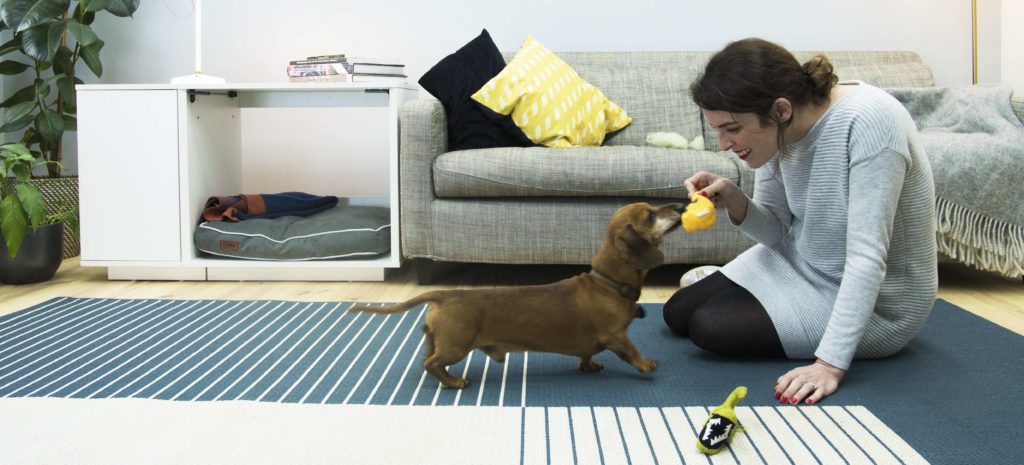
The arrival of a baby in a household turns things upside down. That’s certainly how it can seem to your pets. A dog may find there’s less time for walks and playing, and a cat may suddenly be ousted from her favourite sleeping places in the bedroom or on your lap, due to the presence of the baby.
It’s important to get your pets used to the idea of having the newcomer around, along with the changes in routine that go with it. And ideally the preparation needs to start before the baby is born.
Prenatal Pet Training
In the months leading up to the birth, spend slightly less time with your cat or dog – particularly if they are used to lazing in your lap or sitting by your feet demanding attention.
If your dog is not fully trained at this point, fill in the gaps with some training sessions. Get an expert in to help out, if necessary. Your dog needs to know the basic ‘Sit’, ‘Stay’ and ‘Leave it’ commands, at the very least. It’s essential that the humans in the house reinforce their roles as Alphas in the pack.
A new baby will bring new sounds and smells to the house. You can get your pets ready for this by inviting mums and dads with babies or toddlers to call in for coffee. Play a recording of a crying baby to acclimatise pets’ ears, and switch on any noisy new toys, mobiles, swings or other baby-related apparatus. Let your pets sniff a nappy and a cloth with a few drops of baby oil on it. Familiarity is half the battle.
Get Your Pet Vet-Ready
A neutered pet is a calmer pet, and less likely to bite. This is especially true with males. When neutered, they are less likely to view the baby as a rival. Arrange for a vet to perform the operation, if the pet is not yet neutered. And while you’re there, make sure Puss and Fido are up to date with their vaccinations, worm-free, and generally in tip top health.
Reset Schedules
Babies bring lots of unpredictability to a household, and old routines soon break down. There’s nothing wrong with this, but a pet who’s set in his ways may not take kindly to sudden change. Break him in by varying feeding times, blocking off no-go areas with a baby gate, or perhaps hiring a dog walker.
If the human mum-to-be has always been the pet’s chief companion, it’s handy if you can introduce another ‘favourite’ into its life. This could be a partner, older child or friend – anyone able to spend quality time with the animal.
Introducing the Baby
Before letting a dog or cat see the baby, let them sniff a blanket and a soiled nappy. Try not to show any nervousness when bringing the baby into the house for the first time, as pets will pick up on the bad vibes.
To make the first introduction, sit with the baby in your arms – ideally in a ‘neutral’ room, one where the pet doesn’t usually go – and let the dog or cat approach in its own good time (and one at a time, if you have multiple pets). Don’t force the issue. Have some treats ready to reward good behaviour.
You can reinforce the positive associations by treating a dog whenever it’s around you and the baby. That way your pet will come to associate the baby with good things (i.e. food!) A cat will need less fuss in this respect, and will simply equate the baby with you, logging it as something not to worry about.
Whenever there’s any interaction between baby/toddler and pet, make sure there’s an adult around to keep an eye on the situation.
 Special Notes For Cats
Special Notes For Cats
A docile cat needs to get used to the new baby, and to keep away when it’s asleep. A more flighty cat should simply be kept away. Toddlers seem to have an instinct for grabbing handfuls of pet fur, and a nervous cat may react by scratching. A cat flap with a lock can be handy in the early days, to keep puss outdoors at key times.
Many cats dislike a baby’s crying, and will disappear when the screaming begins. This is very handy! Make sure there’s a quiet, safe spot for them, away from the mayhem. The Maya Nook is a perfect solution to give your cat some privacy.
Cats feel exposed and nervous when they eat, so you should keep a toddler away from the place where your pet is feeding. It should also go without saying that you should prevent young ‘uns from rummaging in the litter tray too!
Special Notes For Dogs
All dogs will need to be well-trained, in a situation where trust is so fundamental. Some dog breeds are very rarely going to be friendly with children, though. A dog bred over hundreds of years for aggression is NOT a dog you should have in the family home. ‘Snappy’ breeds such as Jack Russel, Dachshund or Chihuahua can be problematic too, but you probably know your dog best.
A treat-based puzzle toy such as a Kong ball is a useful distraction. You can give it to your dog while you spend time tending to the baby, to divert the pet’s attention.
It’s important not to abandon dog walks, as that will lead to doggy stress and frustration. It’s a case of ‘business as usual’, where ‘usual’ has simply undergone a few changes.
The dog/child relationship is a two-way process, and youngsters need training too. Teach them to be gentle with the dog, and they will have the basis for a good relationship.
And the importance of that relationship shouldn’t be underestimated. Children learn lots about friendship, respect and responsibility from interacting with animals. There is also evidence that allergies are less of an issue in kids who have been brought up with pets.
So – you’ve replaced your ‘pet baby’ with the real thing. That means big change. But when handled properly it’s a positive change, the beginning of a new chapter in the happy family home.
This entry was posted in Cats on August 22nd, 2019 by linnearask
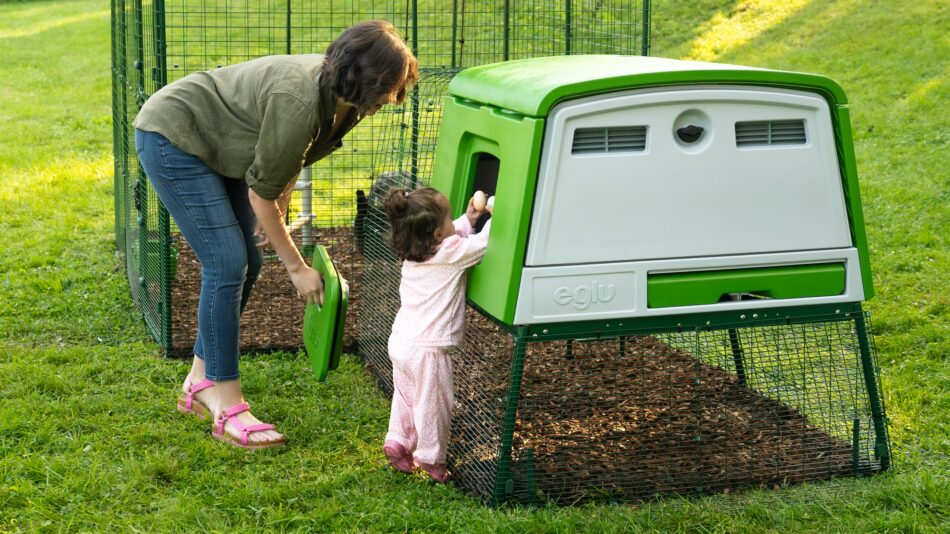
Most flocks of chickens have a routine that their keepers can expect each day. Morning rise and shine, maybe a quick breakfast and romp around the yard, and back to the coop to lay eggs in the nesting box. But what happens when you suddenly don’t find eggs in the nesting box around or after their usual time? Or worse – several days go by with fewer eggs where they should be? There are many reasons why chickens hide their eggs, but we’ll show you how to stop them from doing it.
Why do chickens hide their eggs?
There may be an obvious reason your hens are hiding their eggs, or it may be a combination of external factors. Usually, it’s a problem with the chickens’ nesting box. If conditions are not favourable, hens will seek out alternative locations that may make them feel more comfortable – leading you on an egg hunt each day. Here are the most common qualms hens have about their nesting areas that may cause your chickens to hide their eggs.
Short on space
Each flock is different, but the safest nesting box-to-hen ratio is 1:4. Some hens may be happy to share the same nesting space as 6 or 7 other chickens though, so keep an eye on your numbers. If you notice your hens avoiding the nesting area shortly after adding new flockmates to the mix, it’s probably time for an additional nesting box.
Feeling vulnerable
Nesting areas should be quiet, secluded, and comfortable. If there’s too much commotion around the coop, your hens are more likely to go off in search of a more private area to deposit their eggs. Elevated coops with secluded nesting areas are ideal for making hens feel safe and at ease.
Unfavorable bedding
Bedding that hens can manipulate into a nest shape is a favourite among flocks. Thin straw, shavings, or wood fibre make great nesting box bedding. Hens will shift the bedding around to make a doughnut shape to keep a clutch of eggs safely contained. Stiff substrates like rubber pads, thick straw with little to give to it, or artificial turf are not ideal for creating a welcoming nesting area.
Broody hens
If you have a broody hen in the coop, it’s likely to affect all of your layers. A broody hen will fiercely protect their nesting area and the eggs they’re sitting on, which will deter any other chickens from laying there. And, if a broody hen is occupying the sole nesting box for the flock, other hens will be forced to seek alternative options. Breaking a broody hen is essential to getting the entire flock back into their regular routine.

New layers
Pullets (young hens under a year old) that are new to laying might not catch on right away that the nesting box is where they should lay their eggs. It’s not uncommon for young hens to lay their first few eggs in random locations – in fact, the urge to lay an egg might sneak up on a pullet so quickly that they’ll simply lay an egg wherever they are and continue on with whatever they were doing.
Mites
They may not be visible to the naked eye, but if all of the other conditions are right and your hens are still avoiding the nesting box, it may be due to mites. Mites irritate chickens that come into contact with them, causing intense itching and discomfort. Make sure that your nesting boxes are made of materials that are not favourable to mites and can be cleaned thoroughly. Plastic chicken coops and nesting boxes are the easiest to thoroughly clean, and do a great job of preventing mites in the first place.
Ways to get your hens laying in their nest box
Once you’ve identified and corrected any issues with the nesting box, it’s time to redirect your hens back to their designated laying area. You’ll need to seek out where they’ve been laying their eggs in the meantime. Under the chicken coop, in or under other structures like barns or sheds, between hay bales, and in areas with thick grass or bushes are common places hens will use as alternative nesting spots. If your flock free ranges, you’ll want to keep them inside of their run for a few days to reacquaint them with their new and recently improved nesting box.
Clean the nesting area out at least once a week
Keeping the nesting area clean will help encourage hens to continue laying eggs there. If you have an Omlet chicken coop, simply slide out the droppings tray and pressure wash or wipe it clean, and refresh the bedding for a clean coop in seconds. However, it’s not normal to find droppings in the nesting area itself unless hens are roosting there overnight. If you find droppings in the nesting box regularly, it’s time to add more roosting space.

Decoy eggs
Wooden or rubber eggs can be placed in the nesting box for pullets to get an idea of where to lay their eggs. It can also serve as a reminder to more seasoned hens that the nesting box is where eggs should be laid. You can also place a fresh egg that your flock previously laid in the nesting box to serve as a decoy. Be sure to only use one decoy egg, as a full nest can serve as a deterrent to hens rather than motivation.
Collect eggs regularly
While fresh eggs can be left in the coop for several days and still be edible, it’s good practice to collect eggs every day or two, depending on your flock’s laying frequency. Too many eggs lead to a crowded nesting area, which can deter hens from laying there. Gathering eggs regularly helps reduce the chance of them getting stepped on and broken by other chickens, decreases interest from predators, and ensures optimum freshness.
Your hens and Omlet
Keeping your hens on task with their nesting routine doesn’t have to be difficult. With our large, innovative Eglu Cube Chicken Coop, your flock will have plenty of room to roost without encroaching on the nesting area, an elevated station to feel more protected, and privacy while laying thanks to a dividing partition. Our chicken products foster the natural urges and patterns that drive hens to lay their eggs – taking all the guesswork out of keeping your flock healthy and happy.
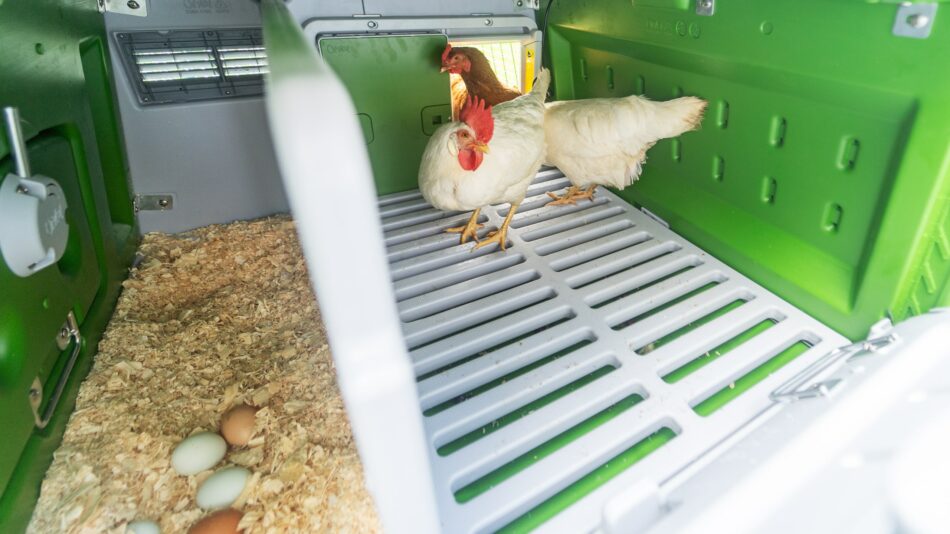
This entry was posted in Chickens on August 20th, 2019 by linnearask
Those who have lost a beloved pet will know the pain can be as heart wrenching as the loss of a family member or friend. For many couples, the family pet becomes another child, just one with four legs and a tail who doesn’t answer back. Many of us also find comfort and friendship in our pets throughout the highs and lows of day to day life, so the passing of a pet can be extremely painful.

It’s okay to be sad
Take the time to process what has happened and allow yourself to be sad. This is especially important if you have children who may be experiencing this kind of loss for the first time and might struggle to understand.
Pet owners often have to make the difficult decision to have their pets put to sleep when their health deteriorates too far to be helped. This adds another aspect to the grief as some may feel guilty for having to make that decision, or as though they could have done things differently. Discuss the events with your vet, as they will be able to reassure you that you did the right thing.
Don’t feel ashamed for any sadness you feel. Many people may not understand or be sympathetic towards the sadness when we lose a pet, but that doesn’t mean you are not allowed to feel upset. If you think it would help you to take a couple of days off work to grieve, do so. Pets who have been in your home for years leave a big hole, and feelings of loneliness and emptiness are completely normal.
Confide in your family and friends about how you feel, but if you do not think they understand, seek the support of organisations such as Blue Cross and Cats Protection who provide grief support helplines.
If they were your only pet, consider moving your pet’s bed, food bowls, toys and other belongings into a garage or shed so they are out of sight. Throwing these in the bin straight away can be difficult so don’t rush, just put them away so there is one less reminder in the home.
If you have another pet, keep a close eye on them for signs of depression and loneliness. Consult a vet if you believe your pet’s behaviour has changed drastically and shows no sign of improvement.
What next?
Some people choose to rescue or adopt another pet soon after the loss, as the home can feel empty without them. However, others find this feels too much like attempting to replace them. Consider rescuing a different type of pet, e.g. if you have lost a dog, why not rescue a cat instead. That way you are not at all replacing your previous pet, but you are offering a cat in need a happy home.
We are all guilty of taking lots of photos of our pets, and this is the time to put those photos to use. Find your favourites and prepare a photo album, or get a canvas printed, so they can still be a part of your home. Other things you could do in memory of your pet are plant a tree or flower in their favourite garden spot, read or write a poem, make a donation to a pet charity which means a lot to you, or volunteer at a local rescue shelter.

Pawprints Left By You – By Vayda Venue
You no longer greet me
As I walk through the door,
You’re not there to make me smile,
To make me laugh anymore,
Life seems quiet without you,
You were far more than a pet,
You were a family member, a friend,
A loving soul i’ll never forget.
It will take time to heal,
For the silence to go away,
I still listen for you ,
And miss you everyday,
You were such a great companion,
Constant, loyal, and true,
My heart will always wear,
The pawprints left by you.
This entry was posted in Dogs on August 15th, 2019 by chloewelch

Did you know that you can tell a lot about your rabbits’ health by looking at their droppings? Rabbit faeces should be very predictable in size, colour, and consistency – anything out of the ordinary could be a red flag for owners. We’ll tell you everything you need to know about rabbit poo, and when it might be time to call the vet.
Different types of poo
Rabbits actually produce two types of droppings, so recognizing what’s normal and what’s not can help you identify potential digestive issues with your rabbit.
Fecal pellets
This is what most people think of when you say rabbit poo. They’re small, round balls made up of mostly undigested hay. These droppings are relatively firm and dry, and they shouldn’t emit much of an odour. There will be lots of these to clean, so take the opportunity to see if they look normal. In fact, rabbits can produce between 200-300 faecal pellets every day.
Faecal pellets should be dark green to dark brown in colour. Their texture should be smooth and round, and they shouldn’t stick to the tray or sides of the hutch. Some rabbits may occasionally get a pellet or two stuck in the hair around their tail, but overall their droppings should be firm enough that this is not a common occurrence.
Cecotropes
These are not actually poo, but little balls of nutrition that the rabbits will pick up and eat again. This might not sound appealing, but they’re a vital part of a rabbit’s diet. So, should you see your bunny munching on these, it’s no cause for alarm – they’re doing as nature intended.
Cecotropes are formed in a part of the digestive system called the caecum. After the food moves through the small intestine, it’s separated into digested and undigested food. Food matter that’s been digested and void of nutritional value will go through the large intestine to be eliminated as pellets. Undigested food will be sent through the caecum where plenty of healthy microorganisms and bacteria will break it down into a form that the body will actually be able to digest. The result is cecotropes that the rabbit will eliminate and ingest again.
Most of the time the rabbit will eat the cecotropes as soon as they are eliminated. If you happen to come across these soft and shiny black balls clustered together like a small blackberry – you’ve found a cecotrope that your rabbit might have missed.
Problems with rabbit poo
Check your rabbit’s poo each time you clean the hutch for any new or irregular bowel movements. Examples of unusual faecal pellets include:
- Smaller or harder than usual
- A foul or strong odour
- Different colour
- Strung together with hair
Issues with diet
The main reason for poo-related problems is an unbalanced diet, or sudden change in diet. Make changes toward a balanced bunny diet, but make sure not to make changes too quickly to avoid digestive upset. A balanced diet for a rabbit consists of roughly 90% good-quality hay and a dish of quality pellets. As a treat, you can offer your rabbits small amounts of rabbit-safe fruits and vegetables or leafy greens in a Caddi Rabbit Treat Holder to elevate their snack time. Make sure your rabbits have access to fresh, clean water at all times to help keep their digestion moving.
Like humans, individual rabbits may react differently to different foods. If you notice your rabbit having very hard or fewer than normal faecal pellets, take it back to the basics. If your bunny is able to regulate their digestion on hay and pellets alone, slowly reintroduce supplemental veggies. Leafy greens like lettuce and cabbage are higher in fibre and easiest for them to digest. Fruits and veggies like carrots are high in starch and should only be offered in small amounts no more than a couple of times per week.
Help them with grooming
If you have long-haired rabbits like Lionheads or Angoras, it’s inevitable that they will ingest some fur during grooming – and what goes in, must come out. You may occasionally find your rabbits’ faecal pellets strung together with long strands of hair. If this occurs more often than once or twice a month, you’ll want to groom your rabbits more often. This is especially helpful in the autumn and spring when rabbits shed their seasonal coats.
Diarrhea warrants a call to the vet
Diarrhoea can be very serious in rabbits – especially during the warmer months of the year when flies are attracted to damp and dirty fur. Fly strike in rabbits occurs when fly larvae hatch from eggs laid by flies that are attracted to your rabbit’s soiled fur. This condition can be fatal to rabbits in a matter of days, so it’s important to address diarrhoea quickly. If their belly isn’t back to normal within 24 hours, it’s time to call the veterinarian.
Diarrhoea can be caused by a number of things, including:
- Dietary changes or poor diet
- Disease
- Stress
Rabbit droppings as fertiliser
Rabbits and gardeners have a complicated history, but rabbit droppings make excellent fertiliser for your garden. Rabbit droppings can be added directly to plants and flower beds right away – it breaks down quickly and doesn’t damage the plants or roots.
Rabbit manure contains 4 times more nutrients than cow or horse manure, and twice as much as chicken manure, but it doesn’t have as much nitrogen in it, which means that it doesn’t have to be composted. Rabbit pellets will continue to release nutrients as they break down, and will improve the structure of the soil. A rabbit hutch with a removable droppings tray makes it simple to dump your rabbits’ droppings directly onto your soil.
A happy home with Omlet
A relaxed rabbit is a happy rabbit, and Omlet understands how to make bunnies comfortable in their abodes. Our Eglu Go Rabbit Hutch is easy for owners to clean, making rabbit droppings readily available for gardening or disposal, and keeping flies to a minimum. The Caddi Rabbit Treat Holder makes serving your rabbits’ nutritious treats fun and easy, eliminating mess and stress. Keep your rabbits’ tummies and your workload in harmony when you choose Omlet for their home.
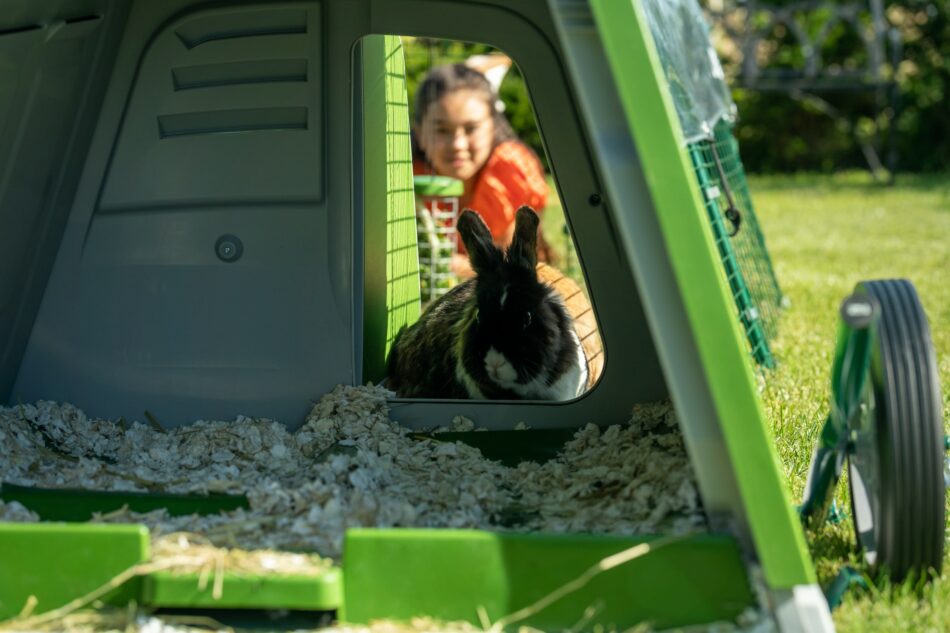
This entry was posted in Rabbits on August 14th, 2019 by linnearask

Thankfully, animal ill health is very much the exception rather than the norm. Many pets go for years suffering nothing worse than the occasional tick, flea or minor wound.
However, if illness or injury strike you can cut the stress by making sure your pet first aid kit is well-stocked and ready to go. Many illnesses will require diagnosis and treatment from a vet, but there are minor problems and non-medical issues that you can easily address yourself.
What you need very much depends on the type of pet you have. But let’s start with some general med-kit classics.
No First Aid Kit Is Complete Without…
- Bandages – self-adhesive or crepe, 2.5 and 5cm width
- Non-adhesive absorbent dressing pads (5cm x 5cm, or smaller for guinea pigs, rabbits, etc)
- Sterile absorbent gauze
- Sterile wipes
- Antiseptic ointment and antibacterial spray
- Surgical tape
- Cotton wool rolls, pads, balls and buds
- Tough scissors – a blunt-ended pair, and a small curve-bladed pair
- A thick towel or blanket
- Disposable gloves
- Tick-remover tweezers
- Iodine, for treating small wounds (including tick wounds)
- Flea and lice comb
- Nail clippers
- Sterile eye wash – for clearing dust, dirt or smoke from the eyes
- A full water container – for washing cuts and dirt, and for hydration
- A mild detergent – for use with the water
- Styptic powder – this stops bleeding from broken nails
- Cornflour (cornstarch) – for staunching minor cuts and abrasions
- Diphenhydramine (or Benadryl) – an antihistamine for mild allergic reactions
- A pet thermometer
- A card with your vet’s phone number, and other useful emergency numbers
- Treats – very useful for rewarding and reassuring a pet who has just been bandaged, tweezered or manhandled in some other undignified manner!
- You should also keep a supply of species-specific flea and mite powders and worming tablets
- For smaller pets, an oral syringe is useful for giving water or liquidised food to an animal that refuses to, or is unable to drink
- A magnifying glass can be useful too, for examining wounds or infestations on rodents, rabbits and cage birds.
Cats and Dogs

Additional items useful for cats and dogs include Elizabethan collars, to prevent your furry friend biting at wounds or dressings. The collar size will vary depending on the size of your pet.
A muzzle is also a very useful inclusion in any dog first aid kit, as even the most placid pet can become afraid and defensive when in pain. You can buy face masks for cats too, with a similar purpose.
First Aid For Birds
Many of the items in the general list above are useful for treating birds. Additional items for avian first aid include a bird net, specifically made for capturing frightened or untamed pet birds in cages and aviaries.
A styptic pencil is an essential tool for staunching wounds resulting from broken feathers or claws. Unlike mammals, birds do not have efficient clotting agents in their blood, and what may appear to be a relatively minor wound can result in death, simply through bleeding. The styptic will swiftly staunch the flow.
A cage sanitizer will help minimise the risk of contagious disease spreading, should one of your birds fall ill. There are various brands available in stores, and your vet will be able to advise you on the most suitable preparation for your particular species of bird.
It is also possible to buy Ivermectin drops from your vet. This medicine kills internal and external parasites, along with the mites responsible for scaly face and scaly leg. It is also used for fur, ear and mange mites and lice in small mammals such as hamsters, gerbils and guinea pigs.
It’s a good idea to keep some wire-cutters in your med-kit too, as birds can sometimes become entangled in loose wires or hangings intended for suspending toys or treats.
Crop needles and blood-feather tweezers can also be useful, but these are precision tools that require expertise to use. Ask a vet or bird breeder for more advice.
DIY is Not Always Best
Pet first aid is fine for minor problems, but in emergencies it is only a stop-gap solution before consulting a vet. Any pet illness needs proper medical care.
A well-stocked first aid kit will, however, save you a lot of time and worry when confronted with pet parasites, small wounds and other conditions that can be tackled with a swift and effective DIY approach.
This entry was posted in Pets on August 12th, 2019 by linnearask
Read this account from a British Hen Welfare Trust volunteer and Omlet customer who recently rescued two ex battery hens. If you want to volunteer or rehome hens, please visit the BHWT website.
As I watched my flock potter about in my garden leading the blissful life and giving me so much in return, from their glorious eggs to laughter at their non-stop antics, I knew I wanted to give back something to these wonderful creatures.
That evening I registered my interest at the British Hen Welfare Trust to become a volunteer. I’d heard stories and seen posts online about ex-battery hens but I don’t think I really had any idea what I was going to face, and the life I was about to see thousands of beautiful ladies live day in and day out.
Picking up my new hens
Volunteer day saw an early rise at 6:30am to get to the farm. The first sight I had was a row of massive windowless barns and I could hear the faint whisper of thousands of voices inside.
I rallied off with the other volunteers who were already carrying out bewildered little faces and loading them into the crates that would be taking them onto their forever homes, where they would finally be loved and get a name.
Upon entering the reality was far worse than I could’ve imagined. So many cramped bald fragile bodies lined in cages five high, as far as the eye could see. Dust and ammonia filled the air, andall I wanted was to get them all out from the dark, away from the bare wires cages as quickly as I could.
Working with other like-minded volunteers was an inspiration, everyone worked so hard. I knew I had to be strong so that I could get some of the girls out of there; that day we got two thousand out of their prisons, all who’d seen nothing but that life for 18 months. At this young age their bodies are nutritional depleted causing them to no long produce eggs to the standard or frequency the industry wants, therefore they are not deemed commercially viable. The harsh reality is that they are then sent for slaughter. Yes, the sad truth is we had to leave some girls behind and really we only make a small drop in the ocean but for those few that do go on to a loving family its means the world.
I personally carried out my two hens, and they happened to be two of the baldest of the lot. One girl, who I called Tess, only had a few feathers on her entire body. I cuddled her in my arms as we drove home, where she shut her little eyes after such a long day realising she could now finally rest.
First few days at home
Once I got Tess and Gloria (named after the song ‘I will survive’) home I let them settle in the cat carrier until the evening with some food and water. They were terrified of me as the only human touch they’d ever previously had was never filled with love.
Even though I have a large walk in run for my flock I knew the girls needed to adjust to every day life at their own pace. They’d never even seen daylight before, instead having 20 hours of artificial light and four hours of darkness to get them to lay as many eggs as possible.
I treated them to their own luxury apartment with a view – a lovely new Eglu Go UP with a 2 meter run and wheels so I could easily move it around the garden and they could snack on as much fresh grass as they wanted. The Eglu is so easy to clean, and another main factor was to keep the dreaded red mite at bay as I did not want anything hindering my precious girls recovery whilst so weak. Looks trendy in the garden too.
Later that evening I gently placed them into the Eglu coop with the door closed so that they could get used to it and get a good night’s sleep. It’s important to allow them time to imprint on their sleeping area, as this will encourage them to go to bed at night on their own.
In the morning I let them out and even though not the most gracious of the descents both came out to explore and dive straight into the Glug and Grub containers. And so began my bonding, greatly helped by their appetite for yummy grapes.
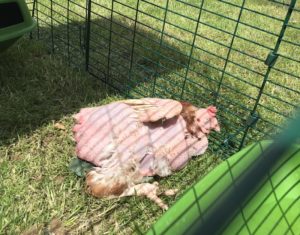
I think my favourite sight in the first few days was them laying in the sun completely at ease and finally acting out natural behaviours like having a dust bath.
They both adapted better each day and I marvel at their ability to take on new situations. It took a little while to understand the concept of a ladder, more so due to the fact they had to build up the strength in their fragile legs, but now that they understand night and day they run up and I find them both snuggled in the coop before lock up when I say sleep tight.
Getting better
Now six weeks on in their freedom journey they are flourishing. They have massive personalities which continue to shine each day: Tess is bold and Gloria is cheeky. Both are growing lots of feathers each day and they fill my heart with such love that I know they feel back.
As I write this both are running around enjoying summer with my other girls in the garden, casually going back to their Eglu run for a bite to eat and a drink before stepping out and having more adventures, because they know thats their forever home.
I want to thank Omlet for giving my girls such an amazing coop to grow old in and enjoy retirement – they love it!
For more information on battery hens and maybe opening up your home to some check out the ‘British Hen Welfare Trust’ for upcoming rehoming dates.
This entry was posted in Chickens on August 10th, 2019 by linnearask
Richard Whately, 19th century Oxford academic and Bishop of Durham, taught his dogs to climb trees on the banks of the river Cherwell, and jump into the water from the branches.

Fortunately, there are much easier ways of getting your pet dog used to taking a dip. But the key word in the previous paragraph is ‘taught’. Dogs are not born swimmers – they need teaching to a certain extent, even though most of them can stay afloat and doggy-paddle their way back to shore if you throw them in. But this is certainly not a recommended way to introduce pooch to the pond!
Many of them need no persuasion at all, and jump into rivers, ponds and the sea at every opportunity. Others are less eager to take the plunge, and some breeds are simply not built for the doggy paddle.
Sorting the Water-Dogs from the Non-Swimmers
Dog breeds with no snout, such as the Boxer, English bulldog, French bulldog, Pekingese and Pug, have great difficulties keeping their noses above the water. Their squashed muzzles – ‘brachycephalic’ is the proper term – means they are simply not built for swimming. Similarly, breeds with large heads and muscular upper bodies such as American bulldogs and Staffordshire bull terriers are not able to swim well, or at all.
Dogs with short legs find it hard to get very far in the water, even though they are capable of holding their heads above the surface. This applies to such breeds as the Basset hound and Dachshund.
Taking the First Dip
For dogs that can swim in theory but are a bit nervous, or simply not yet used to taking a dip, there are a few tips and tricks that should turn them into water dogs in no time.
- Choose a location with water shallow enough for you to easily rescue the dog if it starts to panic. Somewhere with a slope is ideal – a lakeside, a gentle river, or a coastal pool. A paddling pool at home is where many dogs take their first swim.
- Try to choose a quiet location, to minimise distractions and enable the dog to concentrate on the swimming lesson.
- Keep the dog on a long lead during these early dips.
- Take a stick or toy to tempt your dog into the water. If you go in first, the dog will be more inclined to follow. Some will leap in at once, others need more time to get used to the idea. Never drag, throw or otherwise force a dog into water.
- Doggy lifejackets can be bought, if your pet is particularly nervous, or if you’re not sure whether he will be able to swim very well, based on his body shape.
- Once the dog is used to being in the water, wade further out (tricky in a paddling pool!) and encourage him to follow you. It’s all about building confidence.
- To help a nervous dog get used to having its feet off the bottom of the pool or river, hold him by the middle for reassurance. Paddling with the front paws will be instinctive, and you can encourage use of the back legs by raising the dog’s back end slightly. He will instinctively kick his hind legs to regain equilibrium.
- Once the dog is paddling at the front and kicking at the back, he’s cracked it. You can now let him test his new skill – but stay close and be prepared to hold him by the middle again, in case he tires or suddenly panics.
- It’s a good idea to take a towel to dry the dog once it’s emerged from the water. Smaller ones in particular can get cold very quickly. Be prepared for a gentle soaking as your wet pet shakes the water from its coat!
For many dogs, the so-called training process will be over in a couple of seconds. Many hounds swim as naturally as they woof – breeds such as Newfoundlands, Poodles, Otterhounds, the various Retrievers, Spaniels, Setters, and – surprise surprise – Portuguese and Spanish Water Dogs, for example.
And rest assured – you don’t need to teach them to climb trees as well!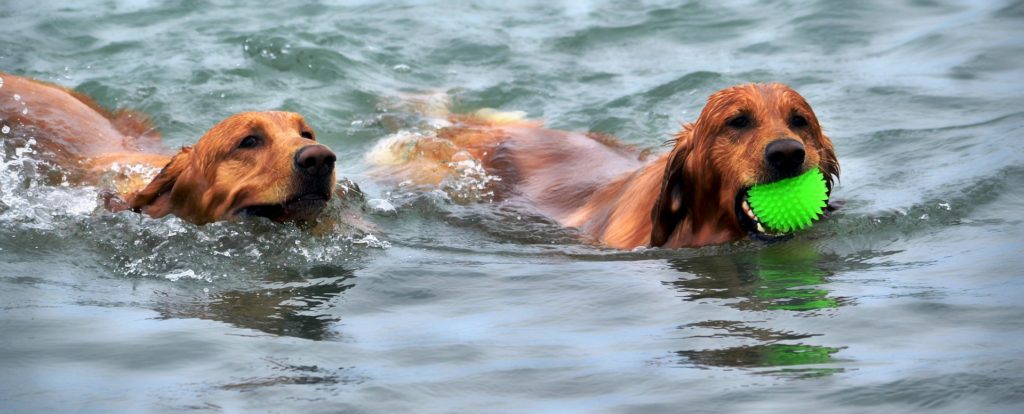
This entry was posted in Dogs on August 7th, 2019 by linnearask
Summertime… Beach stays, trips abroad, hikes in Yorkshire… It is a great opportunity to take a break with your family and keep daily stress at bay. You book a lovely hotel with your other half, you read a map with your children asking them where they want to go, you pack your suitcases, you… Wait! Aren’t you forgetting someone? “Babe, what about the cat? Is he coming with us?!”
Most pet owners tend to forget about it: having a pet means new responsibilities and taking care of them when you go on holidays is one of them. Unfortunately, too many people still ignore it: although the Animal Welfare Act 2006 states abandonment as a criminal offence, the RSCPA received 1 call every 6 minutes to report an abandoned animal last summer. The months of June, July and August are critical since many people seem to struggle when it comes to taking care of their pets while also going on holiday. Read our tips below to make sure your pets will have a great time this summer, just like you!
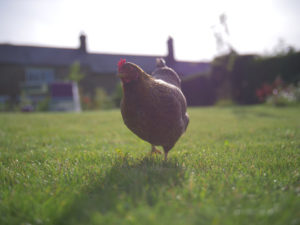 CHICKENS
CHICKENS
You might be an adventurous Frenchman aiming to sail around the world with your hen (https://www.bbc.com/news/world-europe-36475672). However, in all other cases, we recommend that you do not take your chickens on holidays with you. The best thing to do is to ask some friends or neighbours to take care of them while you are away, offering them to help themselves to eggs. If you are lucky enough to have an Eglu Cube on wheels, you can even move your coop directly into your neighbour’s garden!
HAMSTERS, GUINEA PIGS AND RABBITS
Just like with chickens, it is better to leave your hamster, rabbit or guinea pig at home and ask a friend, ideally someone they already know, to come and look after them. If you still decide to take them with you, or if you don’t have any other choice, be very careful with temperature change. These smaller pets are extremely sensitive to it and a sudden temperature change could be fatal. While in the car, make sure that they are neither too hot (do not leave them next to a window or in a parked car) or too cold (do not put them in front of the air con). You also want to check that nothing is at risk of falling and hurting them in the cage: take away the bottle and the feeder and stop regularly to give them some water and food. Remember that rodents and rabbits are very shy animals that like to have their own routine and tend to struggle with change.
CATS
You can definitely take them with you, but in most cases you don’t have to: cats are independent animals that can take care of themselves for a few days. Fill their bowls with food and water before leaving. If you are away for less than 10 days, ask a friend to come and check on them (one or two short visits a day should do).
If you are away for more than 10 days, it is better to leave your cat with some relatives, preferably people who already know your cat and who don’t have any animals that the cat won’t get along with. You can also put your cat in a boarding kennel. However, keep in mind that this can be risky since your cat could feel abandoned (new place, new faces…) and get depressed. Before taking them to the cattery you can give them some soft and natural tranquillizer, like Bach flower, to help them adjust.
DOGS

Dogs are probably the most complicated animal to deal with when going on holidays. You can’t just leave them at home with food and water. This is not only bad for your dog, but could also lead you to be accused of animal cruelty under the Animal Welfare Act 2006 (punishable by a £20,000 fine and a 51-week jail term). The best option is definitely to book a seat for your dog in your car and help them pack their suitcase!
Why should I take my dog with me?
Of course you can leave your dog with your friends or family (preferably someone they already know). However, keep in mind that dogs are very social animals and thrive on their owner’s company. For them, holidays will be a fantastic opportunity to spend some quality time with their favourite humans. Moreover, since you are on holidays, you will have more free time and will be able to spend entire days with your dog, which will make them extremely happy. No more long and boring days waiting for you at home! No doubt that you and your family will also be delighted to spend the whole day playing and exercising with your dog. They can also help you to interact with fellow holiday makers: many people won’t be able to resist giving them some attention!
How to organize a trip with a dog
Here is a list of what you can do to make sure your dog is ready for the holidays and everything goes fine while you two are away from home:
- Before going, make sure your dog is used to travelling in a car. Some dogs can be car sick and it is good to prepare them, especially if you’re planning on a road trip and are spending a lot of time in the car!
- Make sure your dog knows some basic commands such as heel and sit. If they are able to go on a walk without pulling on the lead, it is even better!
- Check that their vaccinations are up to date, and if you’re going abroad, double check what the requirements are far in advance.
- Bring everything they may need: food, of course, but also a first-aid kit, their health record book, the lead, the food and water bowls, the crate, their favourite toys, some poo bags… It is very important to take your dog’s food with you if you are going abroad since you can’t make sure you’ll find their favourite brand in the country you’re visiting.
- While travelling, put your dog in their cage in the boot of the car.
- Before visiting a place, make sure they accept pets. Never go to a hotel before checking it. Likewise, you will easily find on the Internet a list of dog friendly beaches in the UK.
- Check that your dog is not too hot. If you’re going on a walk, don’t forget to bring a bowl and a good amoutn of water.
- When settling your dog somewhere, do it properly: make sure they have some food, some water, some shadow… Even if it is just for an hour!
- If you think it is necessary, you can fit your dog with a GPS collar. This can be useful when you go hiking in the wild. You can also download various apps on your mobile to help you locate a lost dog, find a vets near you or keep record of your dog’s health.
- https://www.fleatickrisk.com/ is a very helpful website that will tell you if your dog is at risk of pest infections in the city you’re visiting. Check the website before going and take the necessary equipment with you.
PUBLIC TRANSPORT
In the UK, you can travel for free with your pet on most public transport: buses, taxis, trains and ferries. However, to make sure everything goes smoothly, always check that that is the case before you board. Be aware that coach companies generally do not accept pets except for assistance dogs. Remember that passengers can complain about your animal’s behaviour so try and make sure your pet will be able to behave themselves while travelling.
When travelling abroad, make sure you can go on public transport with your pet since this can vary according to the country (in some places you will have to book a ticket for your animal).
If you’re travelling by plane, mention that you have an animal when booking and check that your animal’s vaccination is up to date. On the day of the departure, make sure to arrive early. Cats and small dogs will generally be allowed to fly with you in the cabin. However, bigger dogs will have to travel in a heated and pressurized part of the cargo hold. Birds, rabbits and hamsters are often forbidden but some airlines may accept them.
This entry was posted in Pets on August 3rd, 2019 by linnearask
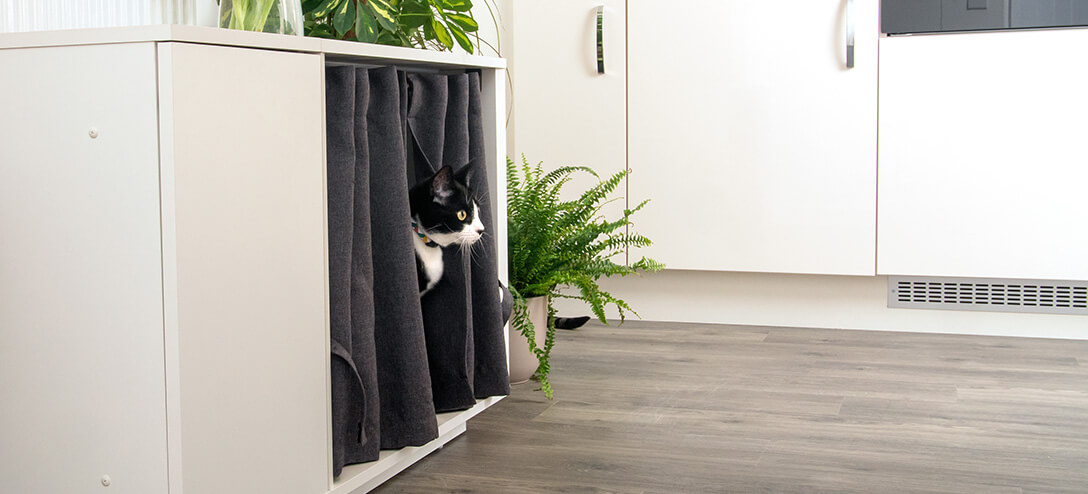
Cats are famous for several things. Independence, hunting and purring, for example. But intelligence? That’s a word more commonly handed out to dogs and parrots.
But that doesn’t mean cats aren’t smart. It’s simply that they don’t show off or shout about it. Under that cool exterior, there may be a lot of brain power.
So, do you have a feline Einstein, or more of a Tired Tom?
To find out how your pet’s grey matter measures up, we’ve put together this fun Cat IQ test. Put puss through her paces and see how she compares to the other brain-fit felines out there! Add up your results in the points column and share them with your friends!
The Omlet Cat IQ Test
1 . How old is your cat?
Less than 1 year
1-5 years
5-10 years
10-15 years
Older than 15
0
1
2
1
0
The years of peak feline fitness are matched by peak brain power.
2 . Does your cat respond to its name?
Yes
No
Sometimes
Yes – along with any other word I say!
3
1
2
1
No zero points here, as a cat that knows its own name may sometimes simply choose to ignore it!
3 . Does your cat sit in the middle of the street?
Often
Sometimes
Never
0
1
2
Basic knowledge of what constitutes a dangerous place is key to cat intelligence.
4 . Does your cat run out in front of cars?
Often
Occasionally
Never
We live away from busy roads, so it’s hard to tell
0
1
2
1
Awareness of danger sorts the smart cat from the not-so-smart.
5 . Does your cat stalk and kill small animals?
Often
Occasionally
Never
Hunts, but doesn’t usually catch anything
3
2
0
1
For a cat, a hunting brain equals a clever brain.
6 . What is your cat like around people?
Loves everyone
Likes family and friends, dislikes strangers
Seems scared of everyone
Has certain people she seems to hate
Doesn’t seem interested in anybody
1
3
1
2
0
A cat that can differentiate between people is a smart puss.
7 . How does your cat react when you come home?
Pleased to see you, rubbing and meowing
Comes to check who it is, but leaves it at that
No reaction (but make sure the cat’s actually in the house before reaching this conclusion!)
3
2
1
Bright cats will be pleased to see you.
8 . How does your pet respond to other cats in the neighbourhood?
In a friendly way
Cautiously
Aggressively
Submissively
Ignores them
1
3
2
1
0
Clever cats need to work out their place in the feline hierarchy.
9 . How does your cat respond to strange dogs?
Runs away
Stands its ground and hisses
Attacks
Ignores them
3
2
1
0
A smart puss knows an enemy when it sees one, and also knows when a fight isn’t worth it!
10 . Present your cat with food she’s not tried before. How does she react?
Refuses to eat it
Sniffs cautiously, possibly with an experimental bite
Eats happily
2
3
1
Not everything is edible, and a sensible cat will show a certain amount of caution.
11 . At feeding time, put an unopened tin of food next to the food bowl. What does the cat do?
Sits and looks at the tin, and then at you
Sniffs and/or rubs against the tin and meows
Examines the tin cautiously and then walks away
Shows no interest in the tin
3
2
1
0
Interaction with the tin suggests that the cat knows it contains food.
12 . Hold one of the cat’s favourite toys in front of her for a few seconds, and then hide it. Make sure your pet is watching as you do this. What does she then do?
Look for the toy, and find it
Look for the toy, but fail to find it
Remain sitting impassively
Walk away
3
2
0
1
Cats don’t always want to ‘play ball’, so it might be worth trying this one a few times before deciding on the result.
13 . Place a windup toy on the floor and let it ‘run’ under a chair, sofa, or other piece of furniture. What does your cat do?
Anticipates were it will emerge, either by moving there or simply watching the space
Looks at you expectantly
Gazes at the place where the toy first set off on its journey
Walks away
Looks away and takes no interest
4
3
2
1
1
A bright puss can deduce where the toy will emerge. But she might just not be in the mood!
14 . Put your shoes and coat on, as if you were about to leave. What is the cat’s reaction?
Meows or rubs against you
Goes to a window ledge to watch you leave
Seems uninterested, or walks away
2
3
1
Observant cats will recognise the clues that mean you’re about to leave the building.
15 . Has your cat learned to – or tried to – open doors, cupboards, windows, etc?
Yes
No
2
0
Clever cats watch and work it out, soon learning that things can be opened.
Scores
The smartest cats are thought to have an IQ equivalent to a 2- or 3-year-old human. How did yours do?
5-10 – Not-So-Cool Cat – Your pet barely has a claw on the IQ scale – less catnip and more training required!
11-19 – Tired Tom – Maybe your cat was feeling a bit lazy today… and every other day, come to that!
20-28 – Purrfect Puss – nothing wrong with this score, although if your cat keeps on looking and listening it might learn even more.
29-37 – Moggy Mastermind – your pet is well above the average when it comes to knowing how the world ticks.
38-42 – Feline Einstein – only a tiny percentage of cats are this clever!
This entry was posted in Cats on August 1st, 2019 by linnearask

















